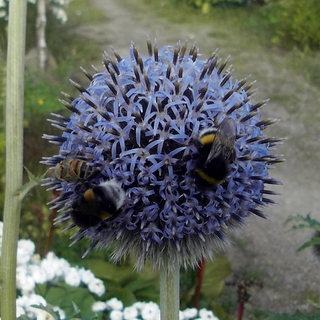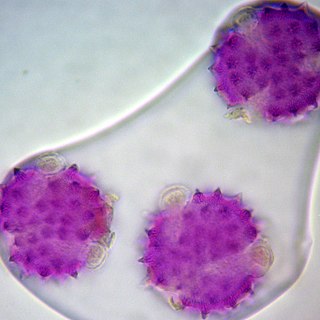
A pollinator is an animal that moves pollen from the male anther of a flower to the female stigma of a flower. This helps to bring about fertilization of the ovules in the flower by the male gametes from the pollen grains.

Hoverflies, also called flower flies or syrphids, make up the insect family Syrphidae. As their common name suggests, they are often seen hovering or nectaring at flowers; the adults of many species feed mainly on nectar and pollen, while the larvae (maggots) eat a wide range of foods. In some species, the larvae are saprotrophs, specifically detritivores, eating decaying plant and animal matter in the soil or in ponds and streams. In other species, the larvae are insectivores, preying on aphids, thrips, and other plant-sucking insects.

Pollination is the transfer of pollen from an anther of a plant to the stigma of a plant, later enabling fertilisation and the production of seeds. Pollinating agents can be animals such as insects, for example beetles or butterflies; birds, and bats; water; wind; and even plants themselves. Pollinating animals travel from plant to plant carrying pollen on their bodies in a vital interaction that allows the transfer of genetic material critical to the reproductive system of most flowering plants. When self-pollination occurs within a closed flower. Pollination often occurs within a species. When pollination occurs between species, it can produce hybrid offspring in nature and in plant breeding work.

In ecology, a biological interaction is the effect that a pair of organisms living together in a community have on each other. They can be either of the same species, or of different species. These effects may be short-term, or long-term, both often strongly influence the adaptation and evolution of the species involved. Biological interactions range from mutualism, beneficial to both partners, to competition, harmful to both partners. Interactions can be direct when physical contact is established or indirect, through intermediaries such as shared resources, territories, ecological services, metabolic waste, toxins or growth inhibitors. This type of relationship can be shown by net effect based on individual effects on both organisms arising out of relationship.

The genus Centris contains circa 250 species of large apid bees occurring in the Neotropical and Nearctic realms, from Kansas to Argentina. Most females of these bees possess adaptations for carrying floral oils rather than pollen or nectar. They mainly visit plants of the family Malpighiaceae to collect oil, but also visit others such as Plantaginaceae, Calceolariaceae, and Krameriaceae. Recent studies have shown they are sister to the corbiculate bees, the most well-known and economically important group of bees

Halictidae is the second-largest family of bees with nearly 4,500 species. They are commonly called sweat bees, as they are often attracted to perspiration. Halictid species are an extremely diverse group that can vary greatly in appearance. These bees occur all over the world and are found on every continent except Antarctica. Usually dark-colored and often metallic, halictids are found in various sizes, colors and patterns. Several species are all or partly green and a few are red, purple, or blue. A number of them have yellow markings, especially the males, which commonly have yellow faces, a pattern widespread among the various families of bees. The family is one of many with short tongues and is best distinguished by the arcuate basal vein found on the wing. Females in this family tend to be larger than the males. They are the group for which the term 'eusocial' was first coined by entomologist, Suzanne Batra.

Ecosystem diversity deals with the variations in ecosystems within a geographical location and its overall impact on human existence and the environment.

Oenothera is a genus of about 145 species of herbaceous flowering plants native to the Americas. It is the type genus of the family Onagraceae. Common names include evening primrose, suncups, and sundrops. They are not closely related to the true primroses.

Trifolium pratense, red clover, is a herbaceous species of flowering plant in the bean family, Fabaceae. It is native to the Old World, but planted and naturalised in many other regions.

Entomophily or insect pollination is a form of pollination whereby pollen of plants, especially but not only of flowering plants, is distributed by insects. Flowers pollinated by insects typically advertise themselves with bright colours, sometimes with conspicuous patterns leading to rewards of pollen and nectar; they may also have an attractive scent which in some cases mimics insect pheromones. Insect pollinators such as bees have adaptations for their role, such as lapping or sucking mouthparts to take in nectar, and in some species also pollen baskets on their hind legs. This required the coevolution of insects and flowering plants in the development of pollination behaviour by the insects and pollination mechanisms by the flowers, benefiting both groups. Both the size and the density of a population are known to affect pollination and subsequent reproductive performance.

Ornithophily or bird pollination is the pollination of flowering plants by birds. This sometimes coevolutionary association is derived from insect pollination (entomophily) and is particularly well developed in some parts of the world, especially in the tropics, Southern Africa, and on some island chains. The association involves several distinctive plant adaptations forming a "pollination syndrome". The plants typically have colourful, often red, flowers with long tubular structures holding ample nectar and orientations of the stamen and stigma that ensure contact with the pollinator. Birds involved in ornithophily tend to be specialist nectarivores with brushy tongues and long bills, that are either capable of hovering flight or light enough to perch on the flower structures.

Bombylius major is a parasitic bee mimic fly. B. major is the most common type of fly within the Bombylius genus. The fly derives its name from its close resemblance to bumblebees and are often mistaken for them.

Krameria erecta is a species of rhatany known by several common names, including Pima rhatany, purple heather, and littleleaf rhatany. It is native to the southwestern United States and northern Mexico, where it grows in dry areas such as desert flats and chaparral slopes. This is a small, tangled shrub under a meter in height with ascending branches covered in silky hairs and fuzzy linear leaves, tips of branches are not thorn-like. The shrub flowers in the spring and again in the fall during wetter years. The showy flower has four or five bright pink cup-shaped sepals and usually five smaller, triangular petals which are pink with green bases. The three upper petals are held erect and the lower two are glandular structures next to the ovary. Next to these are four curving stamens. The species is pollinated by Centris atripes and Centris rhodopus bees. The fruit is a furry heart-shaped body covered in pink spines. It reproduces by seed. This species and others in its genus are root parasites, tapping the tissues of nearby plants for nutrients, especially water. This helps it survive in soil that is almost totally dry.

A pollination network is a bipartite mutualistic network in which plants and pollinators are the nodes, and the pollination interactions form the links between these nodes. The pollination network is bipartite as interactions only exist between two distinct, non-overlapping sets of species, but not within the set: a pollinator can never be pollinated, unlike in a predator-prey network where a predator can be depredated. A pollination network is two-modal, i.e., it includes only links connecting plant and animal communities.

Pollen DNA barcoding is the process of identifying pollen donor plant species through the amplification and sequencing of specific, conserved regions of plant DNA. Being able to accurately identify pollen has a wide range of applications though it has been difficult in the past due to the limitations of microscopic identification of pollen.

The eastern miner bee is a species of miner bee in the family Andrenidae. It is found in North America. It is a specialist in pollinating Fabaceae plants.

Centris nitida is a species of centridine bee in the family Apidae. It is found in Central America. It has also been introduced to the US state of Florida.

Agapostemon virescens, the bicolored striped sweat bee, is a species of sweat bee in the family Halictidae. It is found in North America, and is the official bee of the city of Toronto. Like other species in its genus, A. virescens nests underground, in aggregations wherein multiple females share a single burrow.

UV coloration is a natural phenomenon that leads to unique interactions between organisms that have evolved the ability to perceive these wavelengths of light. It serves as one method to attract pollinators to the flower along with scent, shape, and nectar quality. Flowers are known for their range of visible colors that humans can see with their eyes and observe an array of different shades and patterns. The naked eye cannot see the ultraviolet coloration many flowers employ to bring attention to themselves. By either reflecting or absorbing UV light waves, flowers are able to communicate with pollinators. This allows plants that may require an animal pollinator to stand out from other flowers or distinguish where their flowers are in a muddied background of other plant parts. For the plant, it is important to share and receive pollen so they can reproduce, maintain their ecological role, and guide the evolutionary history of the population.

The genus Chalepogenus, consisting of 21 species of solitary oil-collecting apid bees, demonstrates oligolecty by foraging on oil-producing flowers from the families Calceolariaceae, Iridaceae and Solanaceae. These oil-flowers are abundant in South America, where Chalepogenus is endemic. In contrast to honey bees, Chalepogenus species do not collect nectar; instead, they gather floral oil for various purposes, including provisioning their larvae, constructing nests, and sustaining foraging adult bees. Although oil collection has been reported to be performed by females only, both males and females have specialised oil-collecting structures.



















